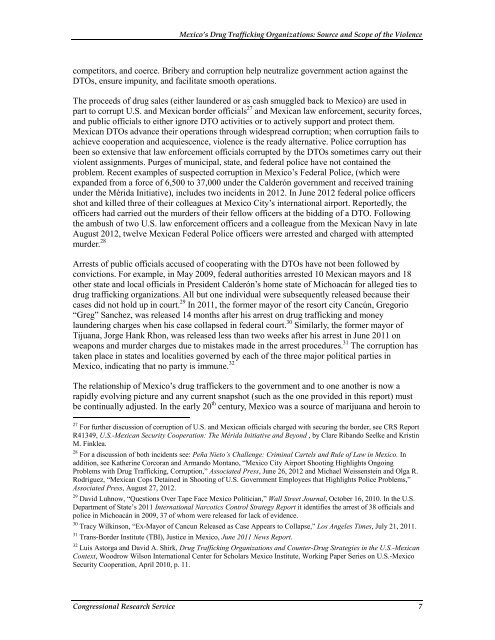Mexico's Drug Trafficking Organizations - Federation of American ...
Mexico's Drug Trafficking Organizations - Federation of American ...
Mexico's Drug Trafficking Organizations - Federation of American ...
Create successful ePaper yourself
Turn your PDF publications into a flip-book with our unique Google optimized e-Paper software.
Mexico’s <strong>Drug</strong> <strong>Trafficking</strong> <strong>Organizations</strong>: Source and Scope <strong>of</strong> the Violence<br />
competitors, and coerce. Bribery and corruption help neutralize government action against the<br />
DTOs, ensure impunity, and facilitate smooth operations.<br />
The proceeds <strong>of</strong> drug sales (either laundered or as cash smuggled back to Mexico) are used in<br />
part to corrupt U.S. and Mexican border <strong>of</strong>ficials 27 and Mexican law enforcement, security forces,<br />
and public <strong>of</strong>ficials to either ignore DTO activities or to actively support and protect them.<br />
Mexican DTOs advance their operations through widespread corruption; when corruption fails to<br />
achieve cooperation and acquiescence, violence is the ready alternative. Police corruption has<br />
been so extensive that law enforcement <strong>of</strong>ficials corrupted by the DTOs sometimes carry out their<br />
violent assignments. Purges <strong>of</strong> municipal, state, and federal police have not contained the<br />
problem. Recent examples <strong>of</strong> suspected corruption in Mexico’s Federal Police, (which were<br />
expanded from a force <strong>of</strong> 6,500 to 37,000 under the Calderón government and received training<br />
under the Mérida Initiative), includes two incidents in 2012. In June 2012 federal police <strong>of</strong>ficers<br />
shot and killed three <strong>of</strong> their colleagues at Mexico City’s international airport. Reportedly, the<br />
<strong>of</strong>ficers had carried out the murders <strong>of</strong> their fellow <strong>of</strong>ficers at the bidding <strong>of</strong> a DTO. Following<br />
the ambush <strong>of</strong> two U.S. law enforcement <strong>of</strong>ficers and a colleague from the Mexican Navy in late<br />
August 2012, twelve Mexican Federal Police <strong>of</strong>ficers were arrested and charged with attempted<br />
murder. 28<br />
Arrests <strong>of</strong> public <strong>of</strong>ficials accused <strong>of</strong> cooperating with the DTOs have not been followed by<br />
convictions. For example, in May 2009, federal authorities arrested 10 Mexican mayors and 18<br />
other state and local <strong>of</strong>ficials in President Calderón’s home state <strong>of</strong> Michoacán for alleged ties to<br />
drug trafficking organizations. All but one individual were subsequently released because their<br />
cases did not hold up in court. 29 In 2011, the former mayor <strong>of</strong> the resort city Cancún, Gregorio<br />
“Greg” Sanchez, was released 14 months after his arrest on drug trafficking and money<br />
laundering charges when his case collapsed in federal court. 30 Similarly, the former mayor <strong>of</strong><br />
Tijuana, Jorge Hank Rhon, was released less than two weeks after his arrest in June 2011 on<br />
weapons and murder charges due to mistakes made in the arrest procedures. 31 The corruption has<br />
taken place in states and localities governed by each <strong>of</strong> the three major political parties in<br />
Mexico, indicating that no party is immune. 32<br />
The relationship <strong>of</strong> Mexico’s drug traffickers to the government and to one another is now a<br />
rapidly evolving picture and any current snapshot (such as the one provided in this report) must<br />
be continually adjusted. In the early 20 th century, Mexico was a source <strong>of</strong> marijuana and heroin to<br />
27 For further discussion <strong>of</strong> corruption <strong>of</strong> U.S. and Mexican <strong>of</strong>ficials charged with securing the border, see CRS Report<br />
R41349, U.S.-Mexican Security Cooperation: The Mérida Initiative and Beyond , by Clare Ribando Seelke and Kristin<br />
M. Finklea.<br />
28 For a discussion <strong>of</strong> both incidents see: Peña Nieto’s Challenge: Criminal Cartels and Rule <strong>of</strong> Law in Mexico. In<br />
addition, see Katherine Corcoran and Armando Montano, “Mexico City Airport Shooting Highlights Ongoing<br />
Problems with <strong>Drug</strong> <strong>Trafficking</strong>, Corruption,” Associated Press, June 26, 2012 and Michael Weissenstein and Olga R.<br />
Rodriguez, “Mexican Cops Detained in Shooting <strong>of</strong> U.S. Government Employees that Highlights Police Problems,”<br />
Associated Press, August 27, 2012.<br />
29 David Luhnow, “Questions Over Tape Face Mexico Politician,” Wall Street Journal, October 16, 2010. In the U.S.<br />
Department <strong>of</strong> State’s 2011 International Narcotics Control Strategy Report it identifies the arrest <strong>of</strong> 38 <strong>of</strong>ficials and<br />
police in Michoacán in 2009, 37 <strong>of</strong> whom were released for lack <strong>of</strong> evidence.<br />
30 Tracy Wilkinson, “Ex-Mayor <strong>of</strong> Cancun Released as Case Appears to Collapse,” Los Angeles Times, July 21, 2011.<br />
31 Trans-Border Institute (TBI), Justice in Mexico, June 2011 News Report.<br />
32 Luis Astorga and David A. Shirk, <strong>Drug</strong> <strong>Trafficking</strong> <strong>Organizations</strong> and Counter-<strong>Drug</strong> Strategies in the U.S.-Mexican<br />
Context, Woodrow Wilson International Center for Scholars Mexico Institute, Working Paper Series on U.S.-Mexico<br />
Security Cooperation, April 2010, p. 11.<br />
Congressional Research Service 7















